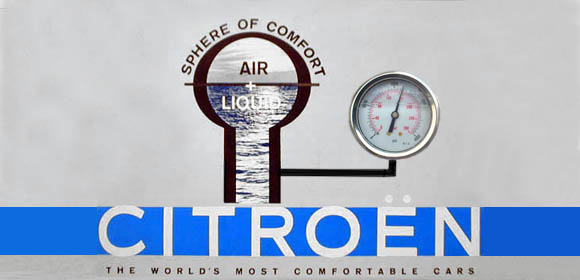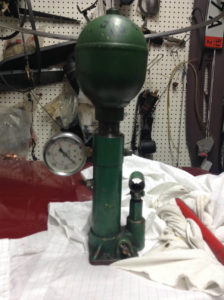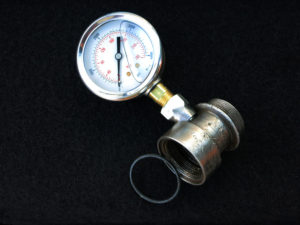An Innovative Way to Check Nitrogen Pressure in Citroën Spheres

(Requires paid member status to access.)
by Prakash Raja……
I wondered why no one has created a fitting (i.e. inline custom made, pressure tested sleeve fitted with a flexible high pressure rated 3000 psi hose and a high pressure gauge) to test Citroen spheres right on the car. You may be thinking, oh not again Prakash but believe me, I know what I am doing. Moreover, I’ve done it and it’s working! I don’t see why such a contraption shouldn’t work for you…
This simple yet effective idea came from the bottle valve and gauge set-up that you find on most gas canisters and fire extinguishers, only it’s a sphere tester. Many of you will know the type that I am referring to; a high pressure gauge fitted to an extension sleeve, seen as per the following…
For the purpose of building this tool the sleeves can be found on one of the front suspension cylinders of a DS.
The conventional way to test a sphere has been on a sphere testing bench apparatus whereby the suspected sphere is removed from the vehicle and screwed it onto the sphere tester. (The Tester should first be filled with LHM and then the square edged round rubber seal placed in-line before the sphere in question is hand tightened onto the tester, making sure the pressure release screw is tightened.
Once mounted, using the pump handle on the tester, you keep pumping until you see the gauge needle is no longer moving and or showing an increase(this means, that it have reached saturation). In my case the sphere I was testing was dead. It had a ruptured membrane and I had to pump an inordinate number of times just to reach 120 Bars on the gauge. I wasn’t about to take a chance and keep pumping until the pressure would register higher or worse – a burst!!!
Hence the idea had came to me from this experience to build an inline sphere tester that could be fitted directly on the car. The vehicle’s hydraulic circuit for the suspension typically has a pressure of 170Bars, plus / minus % cut in /cut out pressure as per the regulator. The rest was easy; I screwed one of these sleeves fitted with a flexible high pressure hose to the side of the sleeve, hose end fitted with a 3500 PSI gauge. In a later iteration of this design I have made and mounted the gauge directly to the sleeve as seen in this picture.
When my Citroën is in normal height setting, car running, the pressure gauge at each wheel registers a value that corresponds with the sphere’s actual nitrogen charge. The good thing about this is that you can check your individual sphere’s health, without any issues.
You can even fit a ^gauge between the hydraulic pump and the pressure relief valve to show you the raw system pressure.
I hope that my method described here will allow those who may want to try out the same to do so. Once again, any advise given, use it at your own risk.
Addendum: Since writing this article, I had learned that in order to protect the gauge needle, due to the abrupt pressure drop and or increase, I had fitted a ^Snubber in line with each gauge on the car. This device basically absorbs varying amount of pressure , much like a shock absorber in a vehicle, hence protecting the gauge from a premature failure to its needle.
Ed Note: We have this tool (the gauge mounted directly to the sleeve version) as part of our CAC loaner tools collection.



